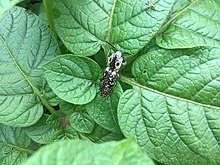
Back دودة سلكية Arabic دوده سلكيه ARZ Şıqqıldaq böcəklər Azerbaijani Шчаўкуны (сямейства насякомых) Byelorussian Полски ковачи Bulgarian Elatèrids Catalan Elateridae CEB Kovaříkovití Czech Smældere Danish Schnellkäfer German
| Click beetles Temporal range:
| |
|---|---|

| |
| Click beetle adults and larvae (wireworms) Left: Wheat wireworm (Agriotes mancus) Right: Sand wireworm (Horistonotus uhlerii) | |
| Scientific classification | |
| Domain: | Eukaryota |
| Kingdom: | Animalia |
| Phylum: | Arthropoda |
| Class: | Insecta |
| Order: | Coleoptera |
| Suborder: | Polyphaga |
| Infraorder: | Elateriformia |
| Superfamily: | Elateroidea |
| Family: | Elateridae Leach, 1815 |
| Subfamilies[2] | |
|
Agrypninae | |
| Synonyms | |
|
Ampedidae | |



Elateridae or click beetles (or "typical click beetles" to distinguish them from the related families Cerophytidae and Eucnemidae, which are also capable of clicking) are a family of beetles. Other names include elaters, snapping beetles, spring beetles or skipjacks. This family was defined by William Elford Leach (1790–1836) in 1815. They are a cosmopolitan beetle family characterized by the unusual click mechanism they possess. There are a few other families of Elateroidea in which a few members have the same mechanism, but most elaterid subfamilies can click. A spine on the prosternum can be snapped into a corresponding notch on the mesosternum, producing a violent "click" that can bounce the beetle into the air.[3] Clicking is mainly used to avoid predation, although it is also useful when the beetle is on its back and needs to right itself. There are about 9300 known species worldwide,[4] and 965 valid species in North America.[5]
- ^ Kusy, Dominik; Motyka, Michal; Bocek, Matej; Vogler, Alfried P.; Bocak, Ladislav (2018-11-20). "Genome sequences identify three families of Coleoptera as morphologically derived click beetles (Elateridae)". Scientific Reports. 8 (1). Springer Science and Business Media LLC: 17084. Bibcode:2018NatSR...817084K. doi:10.1038/s41598-018-35328-0. ISSN 2045-2322. PMC 6244081. PMID 30459416.
- ^ Robin Kundrata, Nicole L. Gunter, Dominika Janosikova & Ladislav Bocak (2018) Molecular evidence for the subfamilial status of Tetralobinae (Coleoptera: Elateridae), with comments on parallel evolution of some phenotypic characters. Arthropod Systematics & Phylogeny 76: 137-145. doi:10.3897/asp.76.e31946
- ^ How the click beetle jumps from the back !. Myrmecofourmis.fr on Youtube. 2015. Archived from the original on 2021-12-21. Retrieved 3 December 2015.
- ^ Schneider, M. C.; et al. (2006). "Evolutionary chromosomal differentiation among four species of Conoderus Eschscholtz, 1829 (Coleoptera, Elateridae, Agrypninae, Conoderini) detected by standard staining, C-banding, silver nitrate impregnation, and CMA3/DA/DAPI staining". Genetica. 128 (1–3): 333–346. doi:10.1007/s10709-006-7101-5. PMID 17028962. S2CID 1901849.
- ^ Majka, C. G.; P. J. Johnson (2008). "The Elateridae (Coleoptera) of the Maritime Provinces of Canada: faunal composition, new records, and taxonomic changes" (PDF excerpt). Zootaxa. 1811: 1–33. doi:10.11646/zootaxa.1811.1.1.
© MMXXIII Rich X Search. We shall prevail. All rights reserved. Rich X Search